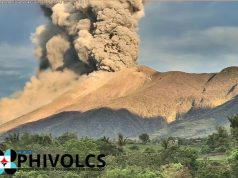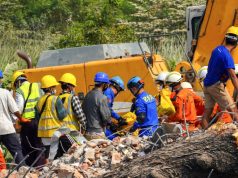
Two government agencies warned the public against false information on earthquakes circulating on social media after two powerful tremors shook different areas in Visayas and Luzon earlier this week.
Text messages and online posts claimed that the hypothetical earthquake called the “Big One” is about to hit Metro Manila and nearby provinces following the two quakes, whose epicenters were in Zambales and Eastern Samar.
The state seismology body previously informed the public of a possible 7.2 magnitude generated by the West Valley Fault, a fault system that traverses major parts in Metro Manila and nearby provinces of Bulacan, Laguna and Cavite.
This feared magnitude 7.2 West Valley Fault movement, however, cannot be predicted, only that it can possibly happen within our lifetime based on historic data spanning generations.
Rumors of it surfaced after the two consecutive earthquakes, but experts from the Philippine Institute of Volcanology and Seismology (Phivolcs) said on Facebook they did not release such information.
PAALALA:Napag-alaman ng aming tanggapan na mayroong kumakalat sa Internet na balita tungkol sa posibleng lindol sa…
Posted by Philippine Institute of Volcanology and Seismology (PHIVOLCS-DOST) on Monday, April 22, 2019
“Nais naming ipabatid sa publiko na hindi nanggaling sa DOST-PHIVOLCS ang mensahe na ito at walang sapat na basehan para maglabas ng warning ang aming tanggapan tungkol sa isang nalalapit na malakas na lindol,” Phivolcs said.
The agency also clarified that the message being spread left out the detail of the government’s contingency plan should the Big One happen.
There’s also no instrument or tool to accurately tell when an earthquake will happen, Phivolcs said, however, this does not stop the agency to monitor an earthquake’s likely sources.
“Patuloy na minamatyagan ng DOST-Phivolcs ang mga lugar na pinagmumulan ng lindol upang magbigay ng sapat na abiso ayon sa nakalap na datos lalo na kapag may kakaibang nangyayari sa mga ito,” the post read.
The Office of Civil Defense and the National Disaster Risk Reduction and Management Council similarly also disproved text messages that claim an 8.0 magnitude earthquake is about to hit the country.
“Nais naming ipahayag na ang nasabing text messages ay mga ‘hoax’ lamang at walang katotohanan,” their statement read on Facebook.
Posted by Civil Defense PH on Tuesday, April 23, 2019
The text blasts sent by the NDRRMC to warn the public of typhoons and earthquakes normally bear the name of the agency.
The civil defense and disaster recovery agencies further warned the public not to be too gullible in consuming information online.
“Hinihikayat ang publiko na huwag magpadala sa mga hina-hinalang text messages at iwasa ang mag-like, share o mag forward ng mga nasabing pekeng mensahe,” they said.
Filipinos should only trust information from these government bodies via their websites and social media accounts.
On April 22, a 6.1 magnitude earthquake caused damage in Zambales, Pampanga and in some cities in Manila.
Less than 24 hours later, another 6.5-magnitude quake rocked Eastern Samar.
The Big One: What you need to know
In 2017, Phivolcs announced that the West Valley Fault was “ripe for movement” and appealed to the public to prepare for the “Big One.”
Phivolcs Director Renato Solidum said that this fault system moves every 400 years. Its last movement which generated an earthquake was in 1658.
A study by the Japan International Cooperation Agency-Phivolcs and the Metropolitan Manila Development Authority in 2004 found that such powerful tremor could kill up to 34,000 people and injure 100,000 more.
To prepare for this calamity, government agencies developed the Oplan Metro Yakal Plus or the Metro Manila Contingency Plan for earthquakes.
Solidum assured the pubic in an interview that the two strong earthquakes are generated by a different fault system, hence, the dreadful West Valley Fault can still move on its own.
“West Valley Fault can move because it is independent of the fault that moved yesterday to cause the Magnitude 6.1 earthquake,” Solidum told CNN Philippines’ “The Source.”
Meanwhile, some Filipinos noted online that the inefficient urban planning will cause their deaths, rather than the earthquake itself.
Nakakatakot yung Big One na lindol as a natural phenomenon. Pero mas nakakatakot yung thought na hindi natin siya masusurvive dahil ang saklap ng sitwasyon ng urban planning sa bansa, incompetent, corrupt at inefficient ang gobyerno, at kampante ang tao.
— Bryan Gonzales (@BuraiGonzaresu) April 23, 2019









